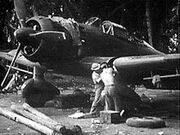The Aichi D3A was a carrier-borne dive bomber used by Japan during World War II.
Description[]
The first production model was the D3A1 and it was given the allied codename "Val". The crew included the pilot and the gunner. The D3A1 also had the air-cooled, 1,000 hp, Mitsubishi Kinsei 43 Engine (early models) along with three propellers.[1] The top speed of the D3A1 was about 389 km/h and the maximum range was about 1,472.3 km The armament of the D3A1 included one rear facing, 7.7mm MG manned by the gunner, two forward facing, 7.7mm MGs mounted in the wings, and either one 249.9 kg bomb in the center of the aircraft or two 59.8 kg bombs in the wings. The wingspan of the D3A1 was about 14.3 meters and the length was 10.2 meters. The rate of climb was about 500 m/s and the empty weight was 2,409 kg.
The loaded weight was 2,618 kg and the service ceiling was 9,160 meters. The landing gear was not retractable and the maximum take of weight was 3,800 kg. The height of the D3A1 was also 3.8 meters. The construction of the D3A was basically totally made of metal. The D3A itself was based on the Heinkel He 70 and had its bombs hit the target four out of every five times.[2]
Variants[]
The D3A1's successor was the D3A2 which had several notable differences. One of these was the new Mitsubishi Kinsei 54 Engine that generated 1,300 hp. It was slightly heavier and faster than the D3A1 and was produced more. Fuel capacity was also increased with the D3A2, but length, crew, and height all remained the same. The D3A2-K variant was not used in combat as it was a training model.
History[]
The D3A was made to replace the older D1A biplane and it did so quite successfully. Prototypes had the original D1A Hikari 1 engine, but because of this, the prototype was underpowered and another flaw were the dive brakes which malfunctioned.[3]

An Aichi D3A2 undergoing repairs
The D3A was finally put into service in 1940 when the Japanese navy designated the Navy Type 99 Carrier Bomber Model 11. The D3A served with the Japanese navy throughout the war whether it was being used in a kamikaze role (this was often put into practice in 1945) or being used as a bomber. The first use of the D3A in combat was over the skies of China. It was soon pressed into service and was used in the Attack on Pearl Harbor and many other battles. Over twenty different ships including destroyers, cruisers, and aircraft carriers were destroyed by D3A bombers. These ships were from Australia, Great Britain, and the United States. The D3A was responsible for the sinking of more ships than any other axis aircraft.[4] The Aichi D3A stopped production in 1944, but was still used by Japanese airmen. The D3A and its variants proved to be an effective bomber although the Yokosuka D4Y Suisei somewhat replaced it.
References[]
| |||||||||||||||||
